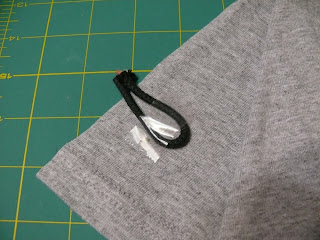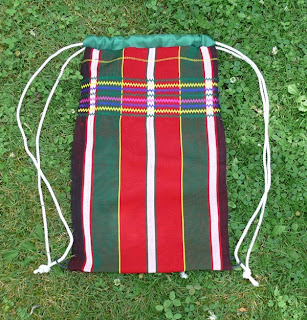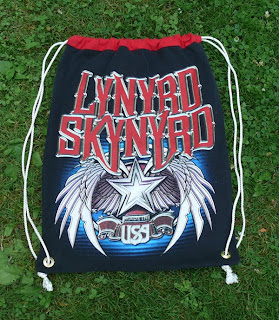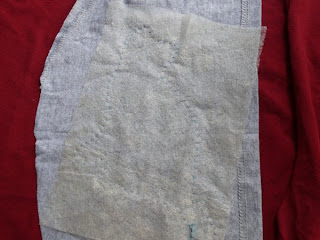Thanks for tuning in to the first GreenStitch podcast! Click on the title of this post to get to Episode 1 -- or,
just click here.Here are some photos and some additional instructions to go along with the audio recording.
For the backpack -- cut four rectangles, all the same size ...two from the T-shirt, two from the lining fabric (which can be another old shirt, or any sort of woven fabric.)
Size varies. Eyeball it!

If you're using corded loops on the lower sides of your bag to thread your arm straps through, "install" them when you stitch the side seams of your T-shirt rectangles. A bit of Scotch tape holds the cord in place until you stitch the seam. Avoid masking tape. Too sticky. Note how the "loop" portion goes toward the fabric. Once you stitch the seam, it'll be going the right way.
Sew your T-shirt rectangles together on three sides (leave one short side open); turn it inside out and press. Do the same with your woven lining, but don't turn inside out. Slip the lining in the T-shirt bag to form one double-thick bag...stitch the raw edges together.

Attach the casings -- two strips, each the width of your bag (when ends are finished and folded about an inch under.) Fold each strip wrong sides together. This shows you how they should meet up at the side seams when you stitch them in place, with all four raw edges together. Your finished ends of the casing strips give you some wiggle room. I fold them in about an inch on each end, but as you get to the meet-up place, you can fold them in more, or ease them out a little -- all with the goal of getting them to meet precisely (or at least reasonably!)

Your cording for the arm straps goes in one casing, and turns right around to go through the second one.

Here's the second strap in place.

Thread one cord through your grommets or loops, tie off at a comfortable place, and you're done.

If you try grommets and mess them up (like I did with this one!) don't worry. Just round off your seam on the inside of the bag (doesn't matter if it has a raw edge inside, nobody will care). When you re-stitch, insert a cord loop in the seam. Done.

You don't have to use T-shirts! Here's a backpack from a table runner I picked up at a neighborhood sale. Lining is ripstop nylon from an old windbreaker jacket.

Free Bird!!!!!!

Here's how to start the reverse applique. Trace your shape onto the right side of your fabric.

On the back side, layer your contrasting fabric and an old dryer sheet for stabilizing. (Some purists argue that the residue in the dryer sheet may deteriorate cotton fibers over time. These aren't likely to end up in museums for the ages, so I say: why worry?)

Stitch around on your tracing line.

Here's what the back will look like -- make sure you've gone through all three layers.

Trim off the excess stuff on the back, leaving a quarter-inch or so around your stitched outline.

From the right side, carefully cut out your shape to reveal the contrast fabric. This is a great technique for T-shirts, as the interlock knit won't ravel.
Be sure and leave comments or suggestions if you have them, and thanks so much for listening! I'll be back with another podcast in a couple of weeks.




































